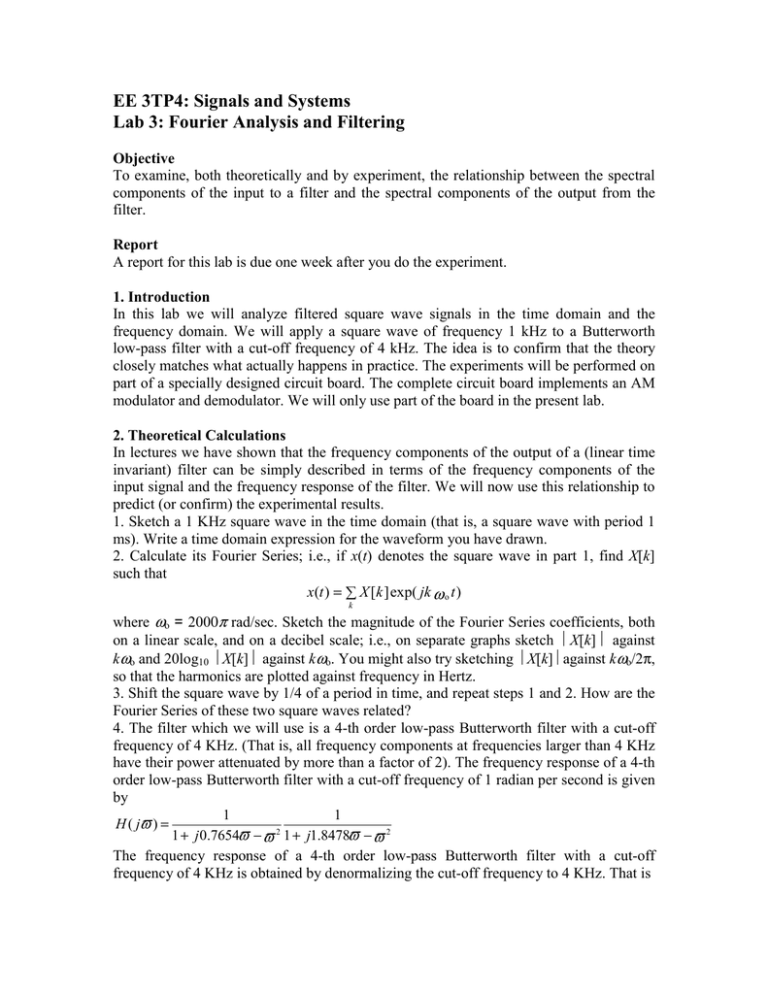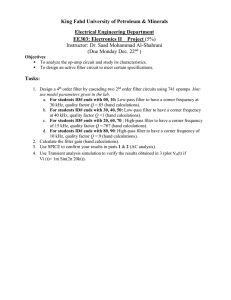Third Experiment
advertisement

EE 3TP4: Signals and Systems Lab 3: Fourier Analysis and Filtering Objective To examine, both theoretically and by experiment, the relationship between the spectral components of the input to a filter and the spectral components of the output from the filter. Report A report for this lab is due one week after you do the experiment. 1. Introduction In this lab we will analyze filtered square wave signals in the time domain and the frequency domain. We will apply a square wave of frequency 1 kHz to a Butterworth low-pass filter with a cut-off frequency of 4 kHz. The idea is to confirm that the theory closely matches what actually happens in practice. The experiments will be performed on part of a specially designed circuit board. The complete circuit board implements an AM modulator and demodulator. We will only use part of the board in the present lab. 2. Theoretical Calculations In lectures we have shown that the frequency components of the output of a (linear time invariant) filter can be simply described in terms of the frequency components of the input signal and the frequency response of the filter. We will now use this relationship to predict (or confirm) the experimental results. 1. Sketch a 1 KHz square wave in the time domain (that is, a square wave with period 1 ms). Write a time domain expression for the waveform you have drawn. 2. Calculate its Fourier Series; i.e., if x(t) denotes the square wave in part 1, find X[k] such that x(t ) = ∑ X [k ] exp( jk ω o t ) k where ωo = 2000π rad/sec. Sketch the magnitude of the Fourier Series coefficients, both on a linear scale, and on a decibel scale; i.e., on separate graphs sketch X[k] against kωo and 20log10 X[k] against kωo. You might also try sketching X[k] against kωo/2π, so that the harmonics are plotted against frequency in Hertz. 3. Shift the square wave by 1/4 of a period in time, and repeat steps 1 and 2. How are the Fourier Series of these two square waves related? 4. The filter which we will use is a 4-th order low-pass Butterworth filter with a cut-off frequency of 4 KHz. (That is, all frequency components at frequencies larger than 4 KHz have their power attenuated by more than a factor of 2). The frequency response of a 4-th order low-pass Butterworth filter with a cut-off frequency of 1 radian per second is given by 1 1 H ( jϖ ) = 2 1 + j 0.7654ϖ − ϖ 1 + j1.8478ϖ − ϖ 2 The frequency response of a 4-th order low-pass Butterworth filter with a cut-off frequency of 4 KHz is obtained by denormalizing the cut-off frequency to 4 KHz. That is H ( jω) = H ( jϖ ) ϖ = ω 8000π 5. Using MATLAB, calculate the frequency response of the filter. Here is a short section of MATLAB code which may help you. (This bit of code only partially completes this question.) Type help polyval for information on how polyval evaluates a polynomial at a particular value of its argument. Type help linspace for information on the linspace command, and type help times for information on the ‘.*’ command. omega = 2*pi*linspace(Min_f, Max_f, number_frequency_points); p1 = [-1, sqrt(-1)*0.7654, 1]; p2 = [-1, sqrt(-1)*1.8478, 1]; omega_bar = omega/(8000*pi); H = 1./(polyval(p1,omega_bar).*polyval(p2,omega_bar)); The variable H is a complex vector containing the frequency response of the filter at the values of (angular) frequency given in omega. Plot the magnitude response of the filter using the command plot(omega,abs(H)); Make sure that you choose Min f and Max f in the code fragment above so that the figure is appropriately scaled. In a different figure, plot the magnitude response of the filter in decibels using plot(omega,20*log10(abs(H))); You may also want to plot these graphs against frequency in Hertz; i.e., plot(omega/(2*pi),abs(H)); figure; plot(omega/(2*pi),20*log10(abs(H))); 6. For the report, explain the above derivations and show how they can be used to calculate the spectral components of the output of the filter. Perform this calculation for the five most important frequencies. Sketch the magnitude of the Fourier Series coefficients of the output on both linear and decibel scales. Use that result to approximate the output of the filter in the time domain, and hence plot two periods of the output waveform (in the time domain). (You can use MATLAB and your programmes from Lab. 1 to produce this time domain plot.) Why did we only look at five components? Did we really need to look at all five to produce an accurate approximation of the time domain waveform at the output of the filter? 3. Time Domain Measurements Please read Appendix A on the operation of the function generator before attempting this section. 1. Turn on the power supply to the circuit board, and turn on the signal generator and the oscilloscope. 2. Apply a 16 KHz square wave with an amplitude of 16V peak-to-peak into the test input on the circuit board. (This input is unfortunately labelled as a “64 KHz input”.) 3. Use the oscilloscope to confirm that this generates a square wave signal of frequency 1 KHz at observation point TP1. (Remember to ground your probes, and to set appropriate scales on the scope.) 4. The signal at TP1 is the input to the Butterworth filter, and the signal at the output of the filter is at TP2. Measure the signal at TP2 and print out two periods of the measured waveform. (Use the ‘Hardcopy’ button on the oscilloscope.) Does this result match your theoretical calculations? Please explain any differences. 4. Frequency Domain Analysis The oscilloscope has a real-time spectral analysis procedure built-in. This allows direct display of the frequency components of a measured signal. Note that the frequency components are displayed in decibels. 1. Set up the spectral analysis functions as shown in Appendix B. 2. Measure the spectrum of the input signal to the filter at TP1, and obtain a hardcopy. Does this match what you calculated in part 2 of Section 2? 3. Measure the spectrum of the output signal from the filter at TP2, and obtain a hardcopy. Does this match what you calculated in part 5 of Section 2? 4. Repeat items 2 and 3 with the horizontal axis of the scope set at 2.5 KHz per division, but do not obtain a hard copy. Observe that some additional peaks have appeared. These peaks are about 30 dB below the fundamental frequency component, but what is interesting is that they do not occur at odd multiples of 1 KHz! The theory does not predict these components? From where could they have come? The answer is that these components do not exist in the signal at TP2. Rather, they are artifacts of the sampling scheme which the scope uses to measure the signal at TP2 and compute its Fourier series components. When we choose 6.25 kHz per division, the sampling rate is chosen to be 250 kilo-samples per second, and the sampling effects are negligible, but when we choose 2.5 kHz per division, the scope chooses a sampling rate of 100 kilo-samples per second, and the sampling effects become significant. These sampling artifacts (also called ‘aliasing effects’) are a direct result of the fact that we cannot distinguish between two discrete-time complex exponentials of the same phase whose (angular) frequencies differ by an integer multiple of 2π. Note that in this lab, the absolute amplitude (or power) of a given frequency component of the output is not important, as it will vary with the input signal amplitude (or power) and the ‘gain’ of the filter. What is important are the relative amplitudes (or powers) between the input and output components at each frequency. Appendix A. Operation of the HP 33120A Function Generator The following procedure describes how to set up this function generator to produce a 16 kHz square wave at 16V peak-to-peak. Set the frequency Push the black “Freq” button. Push the green “Enter Number” button. Push the green “1” and “6” buttons, and then the green “kHz” button. Set the amplitude Push the black “Ampl” button. Use the same “Enter Number” procedure to set the amplitude to 16V peak-to-peak. Set Square Wave Push the black button with the square wave icon on it. Check Check the output waveform on the oscilloscope to confirm that it is a 16 kHz square wave at 16V peak-to-peak. Appendix B. Operation of Spectral Analysis Facility on the Tektronix TDS 210 Digital Scope The following procedure will set up the spectral analysis facility on the scope. 1. Press the “Math Menu” button 2. Select the “FFT” of the appropriate channel 3. Set FFT Zoom = 2. 4. Set the horizontal axis to 6.25 kHz per division (for which the scope uses 250 kilosamples per second sampling). 5. Set the vertical axis to 10 dB per division. 6. Adjust the horizontal position so that the ‘left edge’ of the spectrum (i.e., the DC term) is aligned with a vertical grid line towards the left of the screen. 7. Adjust the vertical position so that the spectrum ‘sits’ on a horizontal grid line near the bottom of the screen.


